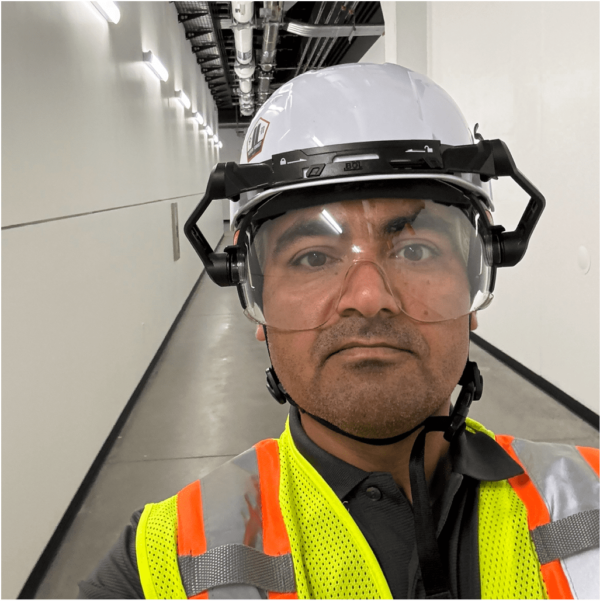
October 22, 2024 | Articles
Walking the Talk: New Vice President, Rail and Transit Gavin Martin

Construction is a complex and expensive endeavor. If a disaster happens to strike amidst active construction, it is important to have a plan in place to mitigate damage to the existing built environment and resume progress without significant schedule impacts. Projects whose anticipated duration is significant or whose locations are in disaster-prone regions are more likely to be impacted by a significant disaster event. For these projects in particular, a disaster recovery plan (DRP) should be devised by the project managers in close collaboration with the owners and other relevant stakeholders.
Underlying the specifics of any disaster recovery plan, a two-fold philosophy should be in place.
– SAFETY: First, you must prioritize safety. No work should resume before conditions are safe to do so. This may involve mitigating unforeseen dangers such as might arise if a construction site containing hazardous materials has been flooded. Or it may merely involve waiting out the duration of a storm and confirming that weather conditions and damage to structural elements can permit work to resume. But in every case, the preservation of human life must be held paramount and achieving that goal should take precedence over all other concerns.
– INTERCONNECTIVITY: Second, a project team must conceptualize its project as being within a web of relationships. The project is not the project alone. Stakeholders, suppliers, engineering professionals and their families, laborers and their families, as well as end users comprise a matrix of relationships that centers upon a project. These parties will all be affected in some way should a calamity strike. These relationships will impact efforts to resume construction in varying ways, according to the extent of the storm and the phase of the project. For instance, a large labor pool may not be able to travel to get to an active construction site or find suitable accommodation once there. Whereas, a design team may be able to work remotely amidst damaged travel infrastructure. Identifying alternative suppliers prior to a project may help to keep work on schedule should a particular supplier’s operations be stifled by a disaster; but when the only supplier of a particular material within a reasonable distance is impacted by a severe disaster, it will not necessarily matter that all the laborers are able to make it to their jobsite. A disaster to strike in the close-out phase of a project may significantly impact its end users’ abilities to finalize the project. In short, all of these relationships have to be examined with regards to how they might impact the ability of a project to move forward under a variety of disaster-borne circumstances.
With this understanding, a project team can craft a DRP that prioritizes safety and understands the interconnectivity of a project with all of its human components. There are also some formal elements that, in most cases, would strengthen a DRP for an active jobsite.
The project team should always evaluate the best and most relevant insurance provisions for their project from the outset of planning. A strong and comprehensive insurance policy is the best way to ensure that the cost of a project does not become astronomically high in the event of a disaster. Contracts that are drafted should include language that carefully details how clients are protected and how project managers will respond in the case of what’s called a “force majeure” or “act of God” event in legal language, i.e. a disaster. The language concerning force majeure should take into account not merely the immediate impacts of the disaster itself, but the lingering effects that may impact the entire web that comprises the project for weeks and perhaps months after the disaster event. Legal professionals will be able to help clarify the cost and schedule provisions agreeable to client and project team in the event of a disaster in the contracted documents.
Project teams should also identify a temporary office setup in a safe location to be used in case of a disaster. Should a calamitous event occur, accurate and prompt written and photographic documentation of the event by an experienced team of professionals is needed to ensure cost recovery via the project’s insurance policy. Specifically, the documentation should include thorough coverage of the nature of the event, an accurate estimation lost money and time, and the damages to the material or current work on the site. Even in cases when work cannot be resumed quickly, some prompt action should be taken in response to the event. Communication must be established with all persons connected to the project. The documentation process should begin when safe enough to do so. Other steps should be taken in accordance with the nature and extent of the disaster for safety/mitigation/etc.
In some cases, hiring a separate disaster recovery entity, such as Hill International, Inc., may be advisable. Especially when the scope of the disaster exceeds any preparation that the project team has undertaken, dedicated disaster professionals may provide the best possible relief. Disaster professionals will be more likely to have the experience and know-how to deal with even tremendous disasters. Moreover, they will often have access to assets that are not necessarily a part of the project’s matrix of relationships and which are thus not impacted by the disaster conditions. For example, while the project management team may have personnel capable of overseeing hazard mitigation work after a disaster, the impact of the disaster on the families or homes of such individuals may impact their abilities to engage in their work immediately after the storm.
By adhering to the two-step philosophy outlined above and merging the formal elements described with the specifics of a particular project, a project team can bolster its project in the case of a natural disaster. Should the difficulties imposed by the disaster exceed the project team’s reasonable expectations, it may be advisable to bring in an outside disaster recovery consultant to support project recovery efforts. A disaster event is, by nature, disruptive. But with careful planning, all the individuals and pieces involved in the construction process can be better protected from physical and financial risk.
About the Author:
Pierre Rousseau, PMP, LEED AP, is a vice president and area manager for Florida & the Caribbean for Hill International’s Orlando office. He has over 26 years of project management and quantity surveying experience and currently leads all of his office’s program management activities. To speak with Pierre about your own disaster plans, reach out via email to [email protected] or call Hill’s Orlando office at (407) 248-8301.
Share

October 22, 2024 | Articles
Walking the Talk: New Vice President, Rail and Transit Gavin Martin

October 18, 2024 | Articles
Future-Proofing Projects: Janakiram VVS Talks India’s Digital Transformation

October 14, 2024 | Articles
Weathering the Storms Part 3: Resiliency Support for Investor-Owned Utilities

October 12, 2024 | Articles
Growing Greener Healthcare: The SNF Global Health Initiative

October 9, 2024 | Articles

October 7, 2024 | Articles
Weathering the Storms Part 2: Leveraging Public Funding for Utility Resiliency

September 30, 2024 | Articles

September 23, 2024 | Articles
Independent Safety Assessments for Rail Projects: Weighing Benefits and Challenges

September 19, 2024 | Articles
Hill Shares Industry Insights to Help Ukrainian Contractors Rebuild

September 19, 2024 | Articles